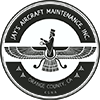Major Alteration:
An alteration not listed in the aircraft, aircraft engine, or propeller specifications, that:
- Might appreciably affect weight, balance, structural strength, performance, powerplant operation, flight characteristics, or other qualities affecting airworthiness; or
- Is not done according to accepted practices or cannot be done by elementary operations.
Major Repair:
A repair that fits one or more of the following:
- Might appreciably affect airworthiness by changing weight, balance, structural strength, performance, powerplant operation, or flight characteristics if improperly done; or
- Is not done according to accepted practices or cannot be done by elementary operations.
A primary responsibility of the holder of an IA is to determine airworthiness by inspecting repairs or alterations for conformity to approved data, and assuring that the aircraft is in a condition for safe operation. During inspection of major repairs or major alterations, the holder of an IA must also determine that they are compatible with previous repairs and alterations that have been made to the aircraft.
The approval action should consist of a detailed examination to establish, at least that:
- All replacement parts installed conform to approved design and/or have traceability to the original equipment manufacturer (OEM).
- As installed, the installation conforms to approved data that is applicable to the installation.
- Workmanship meets the requirements of 14 CFR part 43, section 43.13 (the aircraft or product is equal to its original or properly altered condition).
- The data used is appropriate to the aircraft certification rule (e.g., CAR 3, 14 CFR part 23, FAR 25, FAR 27).
- Work is complete and compatible with other structures or systems.
- The holder of an IA cannot approve the data for major repairs or major alterations. He or she may, however, inspect to see that alterations conform to data previously approved by the FAA (FAR 65, section 65.95). This means the holder of an IA ensures that approved data is available and is used as the basis for the approval. This availability determination should be made prior to beginning the repair or alteration. If data is unavailable, or if the holder of an IA is unsure of the acceptability of the available data, the local Aviation Safety Inspector (ASI) should be consulted. The ASI may, as the circumstances warrant, be able to:
- Establish an acceptable basis for approval,
- Approve the data, or
- Recommend application for a Supplemental Type Certificate(STC).
Quite often major repairs are performed that are eventually covered by fabric, metal skin, or another structure. When this situation exists, the holder of an IA should have a clear understanding with the mechanic performing the repair that a precover inspection is necessary. The inspection should assure that the repair was made in accordance with acceptable methods, techniques, and practices prescribed by FAR 43 and that the structure to be covered is free from defects, corrosion, or wood rot, and is protected from the elements. In addition, the holder of an IA should inspect other affected areas for hidden damage if the aircraft has been involved in an accident or incident. An entry is required to be made in the maintenance record and FAA Form 337, Major Repair and Alteration, must be completed.
Minor deviation from approved data is permissible if the change is one that could be approved as a minor alteration when considered alone. Be sure to list the deviations on FAA Form 337 and make an entry in the maintenance record when completing the aircraft records. When in doubt, contact the local ASI who may decide the change is not minor and would need specific approval or an amendment of the original approval.
Approved data to be used for major repairs and major alterations may be one or more of the following:
- Type Certificate Data Sheets.
- Aircraft Specifications.
- Supplemental Type Certificate (STC) data, provided it specifically applies to the item being repaired/altered. Such data may be used in whole or part as included within the design data associated with the STC.
- Airworthiness Directives (ADs).
- Manufacturer’s FAA Approved Data.
- Designated Engineering Representative (DER) approved data with FAA Form 8110-3, Statement of Compliance.
- Appliance Manufacturer’s Manuals or instructions, unless specifically not approved by the Administrator, are approved for major repairs.
- AC 43.13-1B, Acceptable Methods, Techniques, and Practices (Aircraft Inspection and Repair), may be used directly as approved data (for repairs only) without further approval only when there is no manufacturer repair or maintenance instructions that address the repair and the user has determined that it is:
- A. Appropriate to the product being repaired,
- B. Directly applicable to the repair being made, and
- C. Not contrary to manufacturer’s data.
- This data may also be used as a basis to gain FAA data approval for major repairs.
- FAA Field Approval (FAA Form 337) issued for duplication of identical aircraft may be used as approved data only when the identical alteration is performed on an aircraft of identical make, model, and series by the original modifier.
- U.S. Civil Airworthiness Authority (CAA) Form 337s approved before October 1, 1955, or earlier may be used as approved data.
- FAA-approved portions of Structural Repair Manuals (SRM).
- Data in the form of an Appliance Type Approval issued by the Minister of Transport Canada for those parts or appliances for which there is no current Technical Standard Order (TSO) available. The installation manual provided with the appliance includes the Transport Canada certificate as well as the date of issuance and an environmental qualification statement.
- Foreign bulletins, for use on U.S.-certificated foreign aircraft, when approved by the foreign authority.
Instructions for Completion of FAA Form 337: AC 43.9-1F


